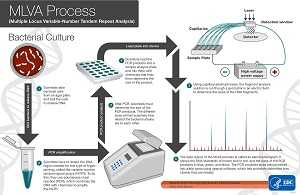Multiple Locus Variable-number Tandem Repeat Analysis (MLVA)
What is MLVA?

MLVA Workflow: Larger View
MLVA, an abbrevation for multiple locus variable number of tandem repeats analysis, is another technique used by microbiologists to generate a DNA fingerprint or a bacterial isolate. Microbiologists usually perform MLVA after they have performed Pulsed-Field Gel Electrophoresis (PFGE) so they can get more details about the type of bacteria that may be causing an outbreak.
Advantages of MLVA
- MLVA may be able to differentiate suspected, fast-evolving bacterial strains from an outbreak even though those strains might look the same using other methods of DNA fingerprinting, such as PFGE..
- PulseNet uses MLVA as a complementary technique to PFGE, allowing microbiologists to see more detailed differences between bacteria that have similar PFGE patterns.
Limitations of MLVA
- Requires a trained and skilled technician
- Is not a practical routine subtyping method because a specific protocol must be used for each pathogen
- A few standardized protocols are available, but only the most common pathogens are subtyped by this method
MLVA Protocols
- Analysis: Shiga-Toxin Producing E. coli O157 Applied BioSystems Genetic Analyzer 3130/3500 [PDF – 10 pages]
- Analysis: Shiga-Toxin Producing E. coli O157 Beckman Coulter CEQ 8000/8800/GeXP [PDF – 10 pages]
- Analysis: Salmonella Enteritidis Beckman Coulter CEQ 8000/8800/GeXP [PDF – 11 pages]
- Analysis: Salmonella Enteritidis Applied BioSystems Genetic Analyzer 3130/3500 [PDF – 10 pages]
- Analysis: Salmonella Typhimurium Applied BioSystems Genetic Analyzer 3130/3500 [PDF – 9 pages]
- Analysis: Salmonella Typhimurium Beckman Coulter CEQ 8000/8800/GeXP [PDF – 10 pages]
- Laboratory Procedure: Shiga-Toxin Producing E. coli O157 Applied Biosystems Genetic Analyzer 3130XL [PDF – 18 pages]
- Laboratory Procedure: Shiga-Toxin Producing E. coli O157 Applied Biosystems Genetic Analyzer 3500 Platform [PDF – 20 pages]
- Laboratory Procedure: Salmonella Enteritidis Applied Biosystems Genetic Analyzer 3130XL Platform [PDF – 18 pages]
- Laboratory Procedure: Salmonella Enteritidis Applied Biosystems Genetic Analyzer 3500 Platform [PDF – 20 pages]
- Laboratory Procedure: Salmonella Enteritidis Beckman Coulter CEQ 8000/8800/GeXP Platform [PDF – 17 pages]
- Laboratory Procedure: Salmonella Typhimurium Applied Biosystems Genetic Analyzer 3130XL Platform [PDF – 18 pages]
- Laboratory Procedure: Salmonella Typhimurium Applied Biosystems Genetic Analyzer 3500 Platform [PDF – 20 pages]
- Laboratory Procedure: Salmonella Typhimurium Beckman Coulter CEQ 8000/8800/GeXP Platform [PDF – 17 pages]
- Page last reviewed: February 16, 2016
- Page last updated: February 16, 2016
- Content source:


 ShareCompartir
ShareCompartir